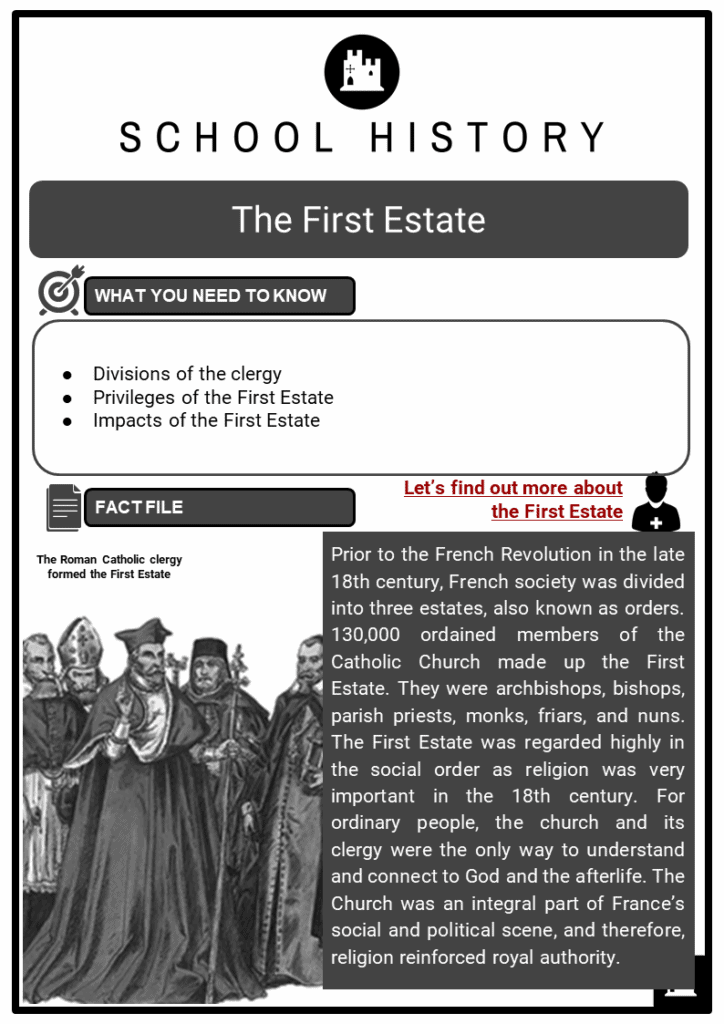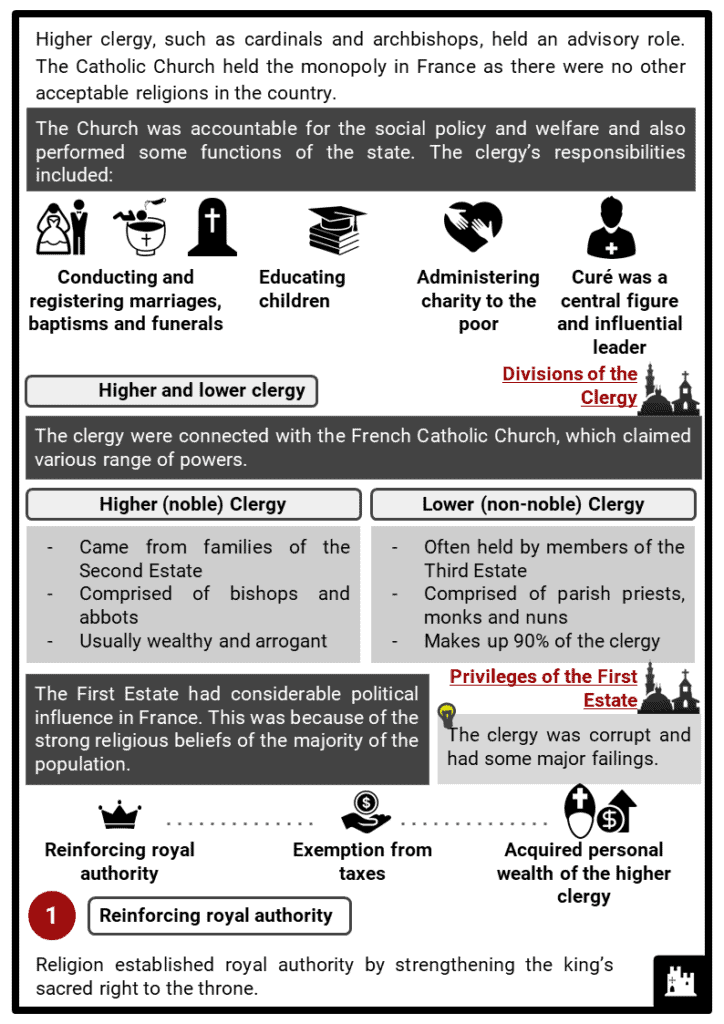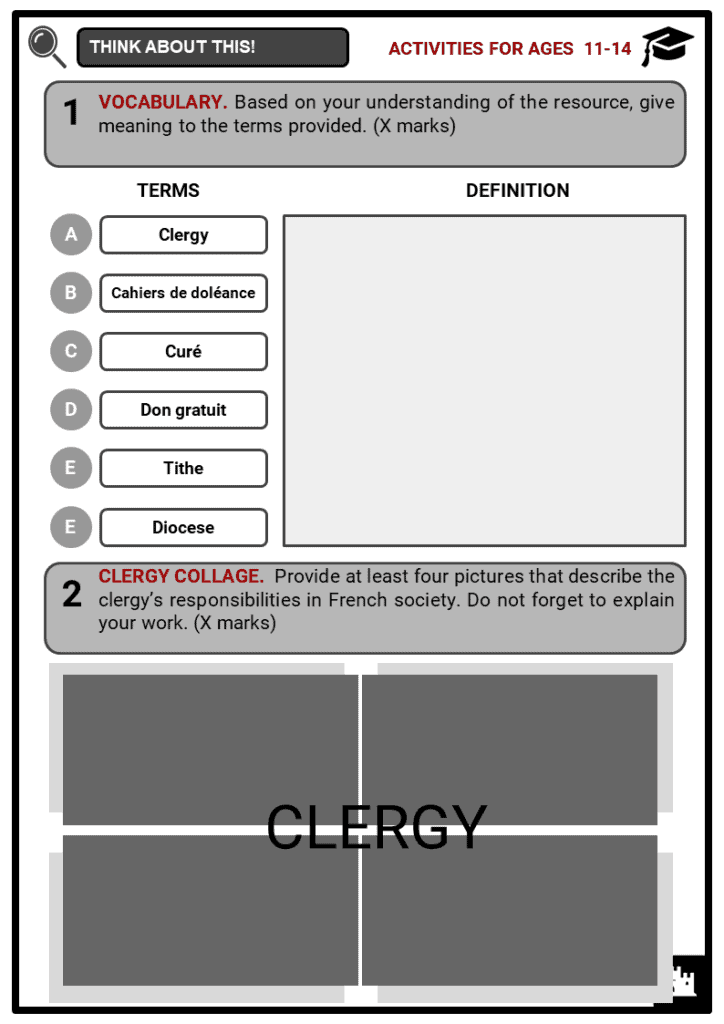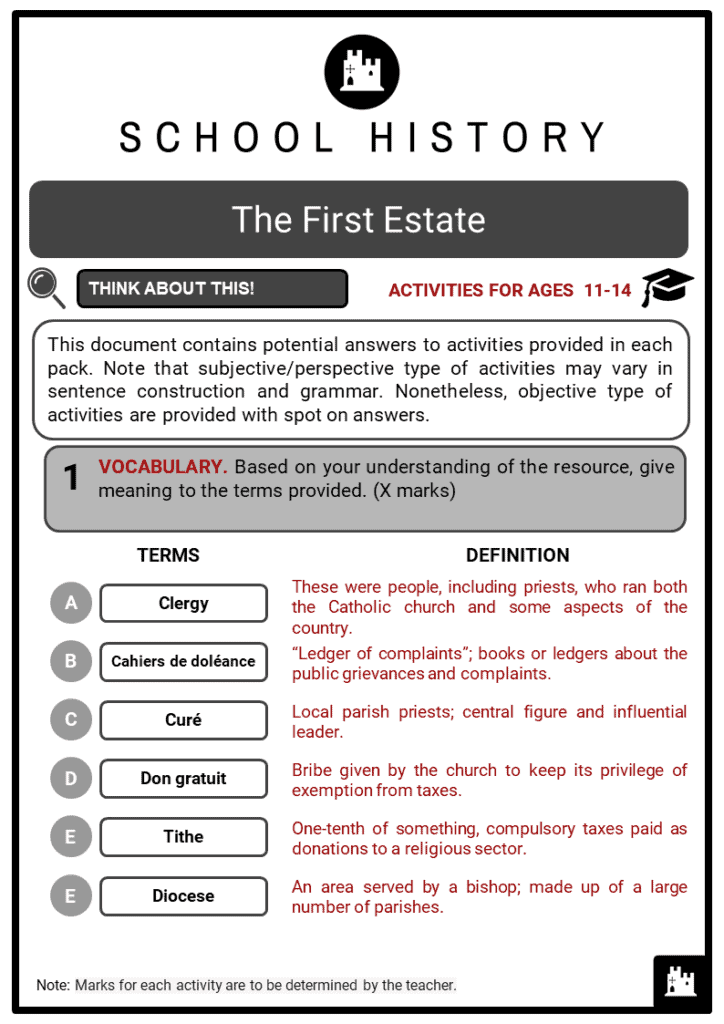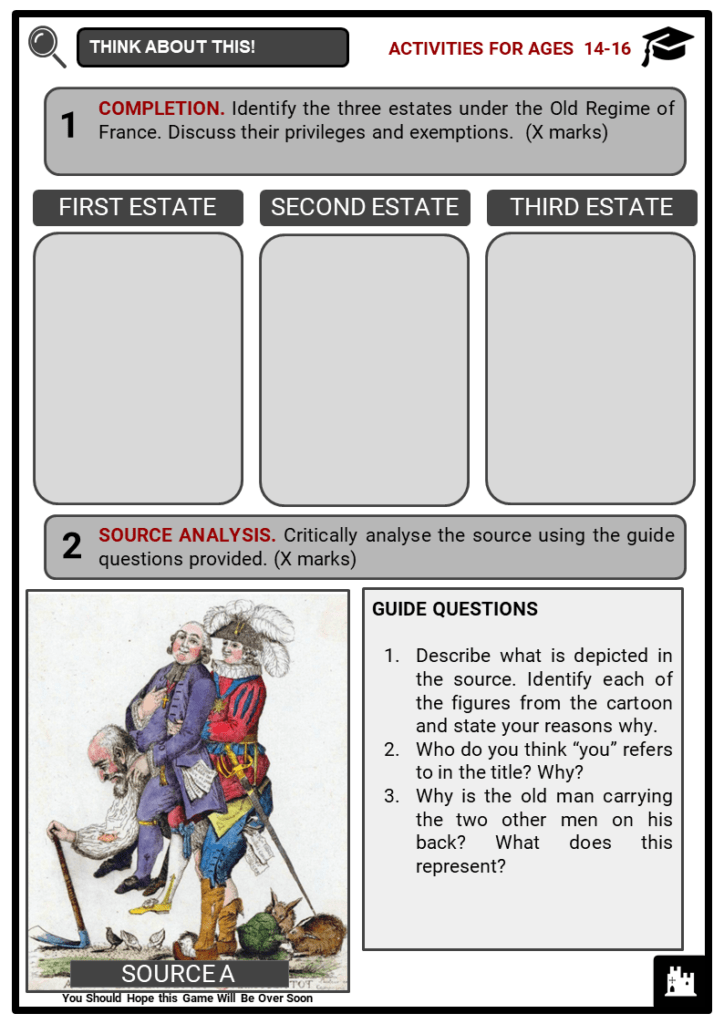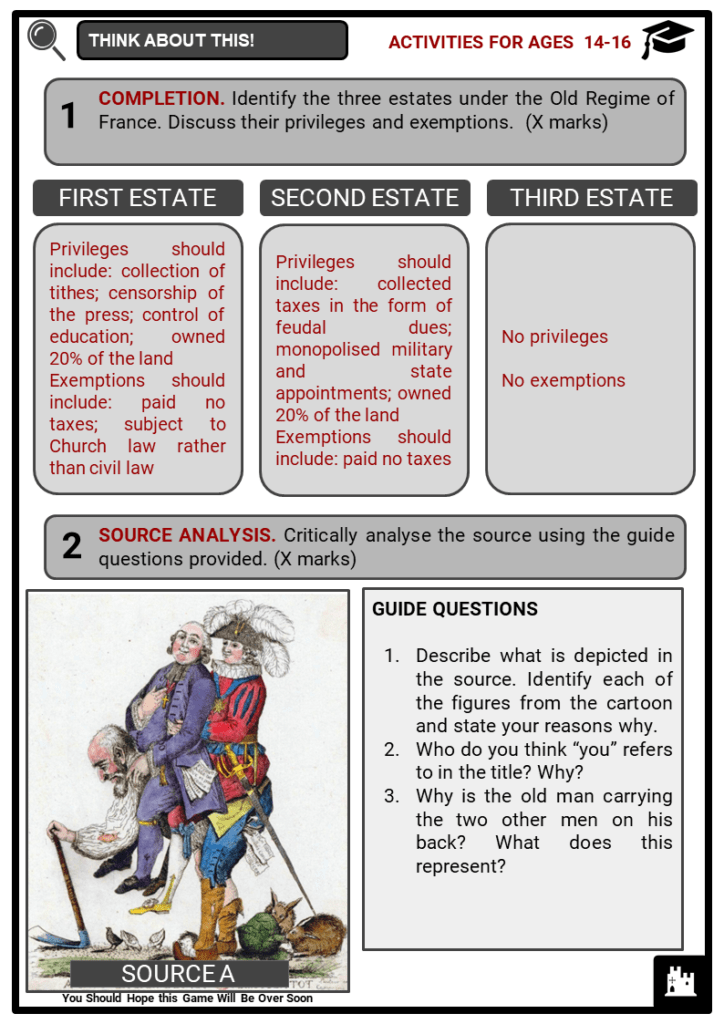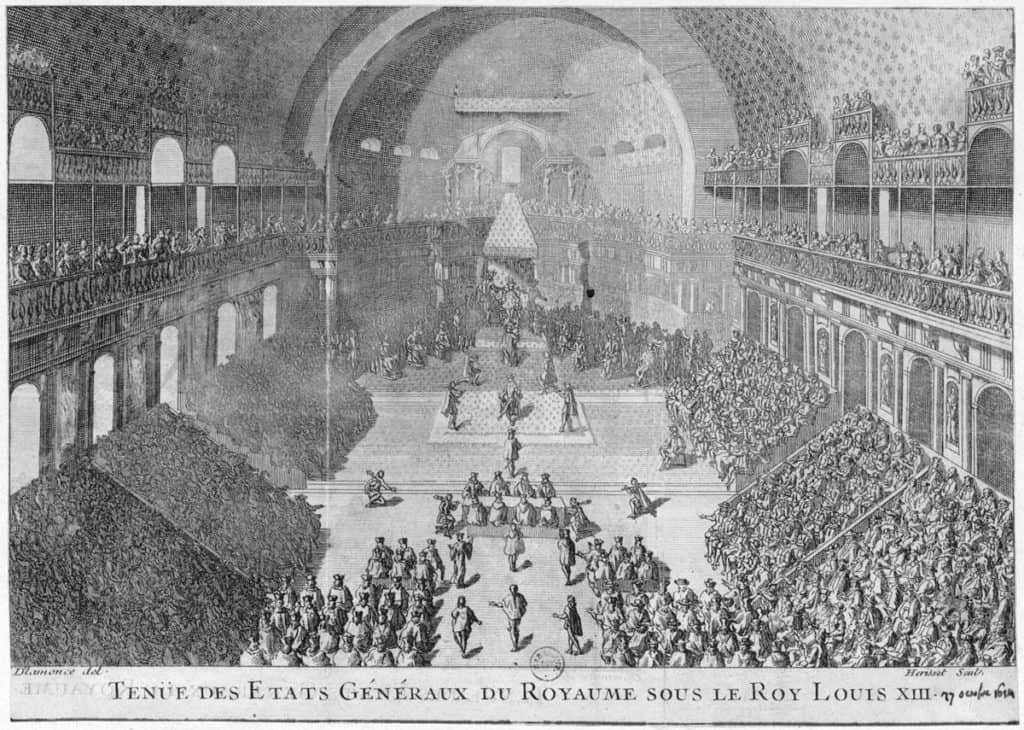Download The First Estate Worksheets
Do you want to save dozens of hours in time? Get your evenings and weekends back? Be able to teach The First Estate to your students?
Our worksheet bundle includes a fact file and printable worksheets and student activities. Perfect for both the classroom and homeschooling!
Table of Contents
Add a header to begin generating the table of contents
Summary
- Divisions of the clergy
- Privileges of the First Estate
- Impacts of the First Estate
Key Facts And Information
Let’s find out more about the First Estate
- Prior to the French Revolution in the late 18th century, French society was divided into three estates, also known as orders. 130,000 ordained members of the Catholic Church made up the First Estate. They were archbishops, bishops, parish priests, monks, friars, and nuns. The First Estate was regarded highly in the social order as religion was very important in the 18th century. For ordinary people, the church and its clergy were the only way to understand and connect to God and the afterlife. The Church was an integral part of France’s social and political scene, and therefore, religion reinforced royal authority.
- Higher clergy, such as cardinals and archbishops, held an advisory role. The Catholic Church held the monopoly in France as there were no other acceptable religions in the country.
Divisions of the Clergy
- Higher and lower clergy
- The clergy were connected with the French Catholic Church, which claimed various range of powers.
- Higher (noble) Clergy
- Came from families of the Second Estate
- Comprised of bishops and abbots
- Usually wealthy and arrogant
- Lower (non-noble) Clergy
- Often held by members of the Third Estate
- Comprised of parish priests, monks and nuns
- Makes up 90% of the clergy
Privileges of the First Estate
- The First Estate had considerable political influence in France. This was because of the strong religious beliefs of the majority of the population.
- The clergy was corrupt and had some major failings.
- Reinforcing royal authority
- Religion established royal authority by strengthening the king’s sacred right to the throne.
- Cardinals, archbishops and anyone belonging to the higher clergy acted as political advisors to the king of France. The state allowed the Catholic church a virtual excessive possession or control of commodity and services over religious matters; there were no other accepted and acknowledged religions in France.
- The Church’s significance meant it amassed huge amounts of wealth; it owned around 10% of all land in France and obtained revenue of roughly 150 million livres annually, usually from tenant rents and tithes.
- Local parish priests are also called “curé”. Tithes, a tenth of something, are compulsory taxes paid as donations to a religious sector or to the government.
- Exemption from taxes
- The Church’s immense yearly income was complemented by immunity from state taxes.
- Challenge Encountered
- In the 17th and 18th centuries, royal government ministers required the clergy to pay a greater share toward the running of the state. These demands could result in increased tensions and violent negotiations, especially during war when the government was prioritising funds for its military needs.
- The don gratuit was, in fact, a bribe given by the Church to keep its privilege of exemption from taxes.
- Solution
- Church leaders agreed to give the state a don gratuit or voluntary gift. This spontaneous donation or payment by the clergy was made every five years.
- In the early 1700s, the clergy was contributing between three and four million livres, a vast amount, but still only around 2% of the church’s overall revenue.
- Acquired personal wealth of the higher clergy
- The clergy’s abundant wealth remained concentrated at the top, instead of filtering down to its lower levels.
- Most of the higher clergy, such as the cardinals, archbishops and bishops, gained a considerable amount of personal wealth from land rents, sinecures or simple graft.
- The majority of the higher clergy lived in luxury, almost similar to the wealthy nobles in the Second Estate. Roughly two-thirds of the bishops and archbishops gained noble titles, either as presents from the kingdom or purchased through bribes.
- Clergies spent huge amounts of money constructing and maintaining gigantic cathedrals in France. These structures outweighed cities and towns, representing the church’s supremacy and influence over French society.
- The First Estate was not only immune from paying taxes; its members were also not required to participate in any form of military service. Clergymen charged with serious crimes could only be prosecuted in churchly courts (i.e. by other members of the clergy) instead of in civil tribunals.
Impacts of the First Estate
- Criticism of the church
- Most French remained vigorously religious. However, by the latter part of the 18th century, French society was filled with dissatisfaction and criticism of the Church.
- Enlightenment writings and ideas opposed and challenged the basis of the Church’s power.
- There was increasing discontent with the higher clergy, a growing sense that bishops, cardinals, and abbots behaved in their own interests rather than the interests of God or the Church itself.
- Disengagement of the Church
- Records show an increasing disenchantment and lack of trust in the Church.
- In the latter part of the 1700s, fewer individuals were enlisting in the priesthood or religious orders, while fewer individuals were leaving their estates to the Church after death.
- Those who left the Catholic Church either fled to Freemasonry, Protestant religions or religious apathy and indifference. However, those who stayed Catholics believed that the Church needed reform and purging of corruption. This dissatisfaction emerged was not only among the non-ordained members of the church.
- There was also an increasing unrest within the lower tiers of the clergy. While all clergy belonged to the First Estate, there was a division of political and theological perspectives within their ranks.
- Unhappy parish priests
- Respected parish priests were often ignored and neglected by the bishops and cardinals and were poorly paid by the Catholic church.
- Roughly one-third of all the clergy were well-educated, hardworking, and compassionate parish priests.
- In the 18th century, a gulf began to arise between some priests, who lived with the commoners of the Third Estate, who witnessed the poor’s sufferings and were summoned by the Estates-General in mid-1789, where 208 of them were well-presented.
- Cahiers de doléance, French for ‘ledger of complaints’’, were books or ledgers about the public grievances and suggestions, written in the first months of 1789 and then submitted to the Estates-General.
- In most cahiers de doléance, parish priests appealed for greater democracy and consultation in the decisions made by the Church, as well as an evaluation of the Church’s immunity of taxation.
- The liberalism of the lower clergy was manifested in their actions at the Estates-General, when 149 of their deputies chose to enlist themselves in the Third Estate to establish the National Assembly.
- “So long as the [French] population retained its keen awareness of the choice between eternal salvation and damnation in the next life, the prestige of the First Estate was assured, for the church alone provided the means to salvation… Its members occupied an important place at every level of society, from the humble country parish ot the royal court itself; and politically the status of the First Estate reflected the power of religion in France and justified the royal title of His Most Christian Majesty.” - Historian JH Shennan’s view
- The First Estate had considerable political influence in France. This was because of the strong religious beliefs of the majority of the population.
- The criticism of the church came from the lower clergy as these members wanted to have a greater say and for the Church to be more accountable.
Image sources:

